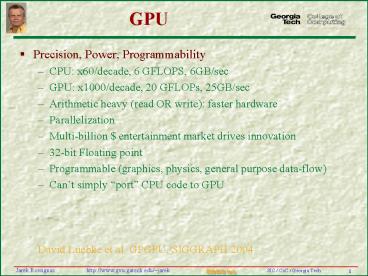GPU PowerPoint PPT Presentation
Title: GPU
1
GPU
- Precision, Power, Programmability
- CPU x60/decade, 6 GFLOPS, 6GB/sec
- GPU x1000/decade, 20 GFLOPs, 25GB/sec
- Arithmetic heavy (read OR write) faster hardware
- Parallelization
- Multi-billion entertainment market drives
innovation - 32-bit Floating point
- Programmable (graphics, physics, general purpose
data-flow) - Cant simply port CPU code to GPU
- David Luebke et al. GPGPU, SIGGRAPH 2004
2
History of the 3D graphics industry
- 60s
- Line drawings, hidden lines, parametric surfaces
(B-splines) - Automated drafting machining for car,
airplane, and ships manufacturers - 70s
- Mainframes, Vector tubes (HP)
- Software Solids, (CSG), Ray Tracing, Z-buffer
for hidden lines - 80s
- Graphics workstations (50K-1M) Frame buffers,
rasterizers , GL, Phigs - VR CAVEs and head-mounted displays
- CAD/CAM GIS CATIA, SDRC, PTC
- Sun, HP, IBM, SGI, ES, DEC
- 90s
- PCs (2K) Graphics boards, OpenGL, Java3D
- CADVideogamesAnimations AutoCAD, SolidWorks,
Alias-Wavefront - Intel, many board vendors
- 00s
- Laptops, PDAs, Cell Phones Parallel graphic
chips - Everything will be graphics, 3D, animated,
interactive - Nvidia, Sony, Nokia
3
History of GPU
- Pre-GPU Graphics Acceleration
- SGI, Evans Sutherland. Introduced concepts like
vertex transformation and texture mapping. Very
expensive! - First-Generation GPU (-1998)
- Nvidia TNT2, ATI Rage, Voodoo3. Vertex
transformation on CPU, limited set of math
operations. - Second-Generation GPU (1999-2000)
- GeForce 256, Geforce2, Radeon 7500, Savage3D.
Transformation Lighting. More configurable,
still not programmable. - Third-Generation GPU (2001)
- Geforce3, Geforce4 Ti, Xbox, Radeon 8500. Vertex
Programmability, pixel-level configurability. - Fourth-Generation GPU (2002-)
- Geforce FX series, Radeon 9700 and on.
Vertex-level and pixel-level programmability.
4
Architecture
Application
Vertex Shader
transformed vertices, normals, colors
Geometry Shader
Rasterizer
fragments (surfels per pixel)
texture
Fragment Shader
pixel color, depth, stencil
Compositor
Display
5
Buffers
- Color 8-bit index to color table, float/16-bit
true color - Depth 24-bit or float (0 at back plane)
- Back and front display front, update back, swap
- Stereo Shutter glasses, HMD. Alternate frames
- Auxiliary off-screen working space. Helps reduce
passes. - Stencil 8 bits (left-over of depth buffer). lt,gt
mask, - Accumulation sum, scale (supersampling, blur)
- P-buffer, superbuffers Render to texture
6
Fragment operations
- Depth tests lt, lt, gt, lt, , Z?depth-interval
- Stencil test mask?, counter, parity.
- Alpha tests compare to reference alpha
- Alpha blending max, min, replace, blend
7
Data Parallelism in GPUs
- Data flow vertices gt fragments gt pixels
- Parallelism at each stage
- No shared or static data (except textures)
- ALU-heavy (multiple ALUs per stage in pipe)
- Fight memory latency with more computation
8
GPGPU
- Stream collection of records (pixels, vertices)
- Stored in Textures (a computational grid)
- Kernel Function applied to each element in
stream - Transform, evolve (no dependency between records)
- Matrix algebra
- Image/volume processing
- Physical simulation
- Global illumination
- Ray tracing
- Photon mapping
- Radiosity
9
Computational Resources
- Programmable parallel processors
- Vertex Fragment pipelines
- Rasterizer
- Mostly useful for interpolating addresses
(texture coordinates) and per-vertex constants - Texture unit
- Read-only memory interface
- Render to texture (or Copy to texture)
- Write-only memory interface
10
Vertex Processor
- Fully programmable (SIMD / MIMD)
- Processes 4-vectors (RGBA / XYZW)
- Capable of scatter but not gather (Ai,jx)
- Can change the location of current vertex
- Cannot read info from other vertices
- Can only read a small constant memory
- Vertex Texture Fetch
- Random access memory for vertices
- Arguably still not gather
11
Fragment Processor
- May be invoked at each pixel by drawing a full
screen quad - Fully programmable (SIMD)
- Processes 4-vectors (RGBA / XYZW)
- Random access memory read (textures)
- Capable of gather (xAi1,j) and some scatter
- RAM read (texture), but no RAM write
- Output address fixed to a specific pixel
- But can change that address
- Typically more useful than vertex processor
- More fragment pipelines than vertex pipelines
- Gather
- Direct output (fragment processor is at end of
pipeline)
12
Branching
- Not supported or expensive
- Avoid, replace by math
- Depth test
- Stencil test
- Occlusion query (conditional execution)
- Pre-computation (region of interest, use to set
stencil mask)

